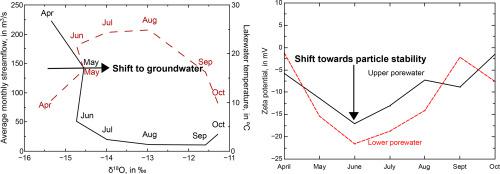Journal of Contaminant Hydrology ( IF 3.5 ) Pub Date : 2020-05-15 , DOI: 10.1016/j.jconhyd.2020.103655 Jeff B Langman 1 , David Behrens 1 , James G Moberly 2

|
Formation of dissolved metal particles (<450 nm) in mining-impacted environments is a concern because of their potential for greater mobility and ecotoxicity compared to free ion and(or) sediment-bound metals. Metal-contaminated environments may produce soluble metal(loid) particles whose stability and transportability are determined by environmental conditions and particle composition. The Coeur d'Alene River Basin of northern Idaho, USA, is impacted by legacy mine waste—estimated 56 million tonnes of waste rock containing 900,000 t of Pb and 700,000 t of Zn were discharged into the Coeur d'Alene River and its tributaries during mining of argentiferous galena-sphalerite deposits. These legacy disposal practices resulted in substantial metal contamination—including As, Cd, Fe, Pb, Mn, and Zn—of floodplain sediments. Monthly lakewater samples and sediment cores were collected along the shoreline of a metal-contaminated lateral lake of the Coeur d'Alene River. Porewater was extracted from upper and lower sediments to evaluate the formation and stability of dissolved metal particles during seasonal changes. Substantial concentrations of Fe, Pb, Mn, and Zn were present in 450-nm filtered porewater during each month, with variable increases and decreases of metal concentrations in filtered lakewater according to seasonal changes. Dissolved metal particles with an average diameter of 180 ± 115 nm were present in the porewater of the upper and lower sediments with size increases in early spring and decreases in fall. Particles in the lower sediment porewater were typically more stable, as indicated by more negative ζ potential values, and the greatest particle stability occurred during summer. Differences between upper and lower porewater metal particles correspond to changes in sediment S speciation and bond relocation resulting from an input of oxygenated groundwater. Transport of the dissolved metal particles in and from the sediments likely occurs with a change in the hydraulic gradient during a spring-to-summer transition that induces redox changes and increases particle stability. The presence of mining-related minerals and seasonal changes in environmental conditions allow for formation of dissolved metal particles, but the limited stability of the particles and/or low permeability of the sediments appear to limit, but not fully restrict, possible transport of metal particles to the overlying lakewater.
中文翻译:

受采矿影响的湖相沉积物中溶解金属颗粒的季节性形成和稳定性。
在受采矿影响的环境中,溶解金属颗粒(<450 nm)的形成令人担忧,因为与自由离子和(或)与沉淀物结合的金属相比,它们具有更大的迁移率和生态毒性。被金属污染的环境可能会产生可溶性金属(胶体)颗粒,其稳定性和可运输性取决于环境条件和颗粒组成。美国爱达荷州北部的科达伦河流域受到遗留矿山废料的影响,据估计,在此期间,含有900,000吨铅和70万吨锌的5600万吨废石排入科达伦河及其支流银色方铅矿-闪锌矿矿床的开采。这些传统的处置方法导致洪泛区沉积物大量金属污染,包括砷,镉,铁,铅,锰和锌。沿Coeur d'Alene河被金属污染的侧湖的海岸线收集了每月的湖水样品和沉积物芯。从上部和下部沉积物中提取孔隙水,以评估季节性变化过程中溶解的金属颗粒的形成和稳定性。每个月450 nm过滤的孔隙水中都存在大量的Fe,Pb,Mn和Zn浓度,并且过滤后的湖水中金属浓度会随季节变化而变化。上部和下部沉积物的孔隙水中存在平均直径为180±115 nm的溶解金属颗粒,其大小在早春增加而在秋天下降。更低的ζ电位值表明,下部沉积物孔隙水中的颗粒通常更稳定,并且最大的颗粒稳定性发生在夏季。上部和下部孔隙水金属颗粒之间的差异对应于由含氧地下水的输入引起的沉积物S形态变化和键迁移。在春季到夏季的过渡期间,水力梯度的变化可能会导致溶解的金属颗粒在沉积物中和从沉积物中的迁移,从而引起氧化还原变化并增加颗粒的稳定性。与采矿有关的矿物的存在和环境条件的季节性变化允许形成溶解的金属颗粒,但是颗粒的有限稳定性和/或沉积物的低渗透性似乎限制(但不完全限制)金属颗粒的可能运输到上方的湖水。上部和下部孔隙水金属颗粒之间的差异对应于由于含氧地下水的输入而导致的沉积物S形态变化和键迁移。在春季到夏季的过渡期间,水力梯度的变化可能会导致溶解的金属颗粒在沉积物中和从沉积物中的迁移,从而引起氧化还原变化并增加颗粒的稳定性。与采矿有关的矿物的存在和环境条件的季节性变化允许形成溶解的金属颗粒,但是颗粒的有限稳定性和/或沉积物的低渗透性似乎限制(但不完全限制)金属颗粒的可能运输到上方的湖水。上部和下部孔隙水金属颗粒之间的差异对应于由含氧地下水的输入引起的沉积物S形态变化和键迁移。在春季到夏季的过渡期间,水力梯度的变化可能会导致溶解的金属颗粒在沉积物中和从沉积物中的迁移,从而引起氧化还原变化并增加颗粒的稳定性。与采矿有关的矿物的存在和环境条件的季节性变化允许形成溶解的金属颗粒,但是颗粒的有限稳定性和/或沉积物的低渗透性似乎限制(但不完全限制)金属颗粒的可能运输到上方的湖水。









































 京公网安备 11010802027423号
京公网安备 11010802027423号